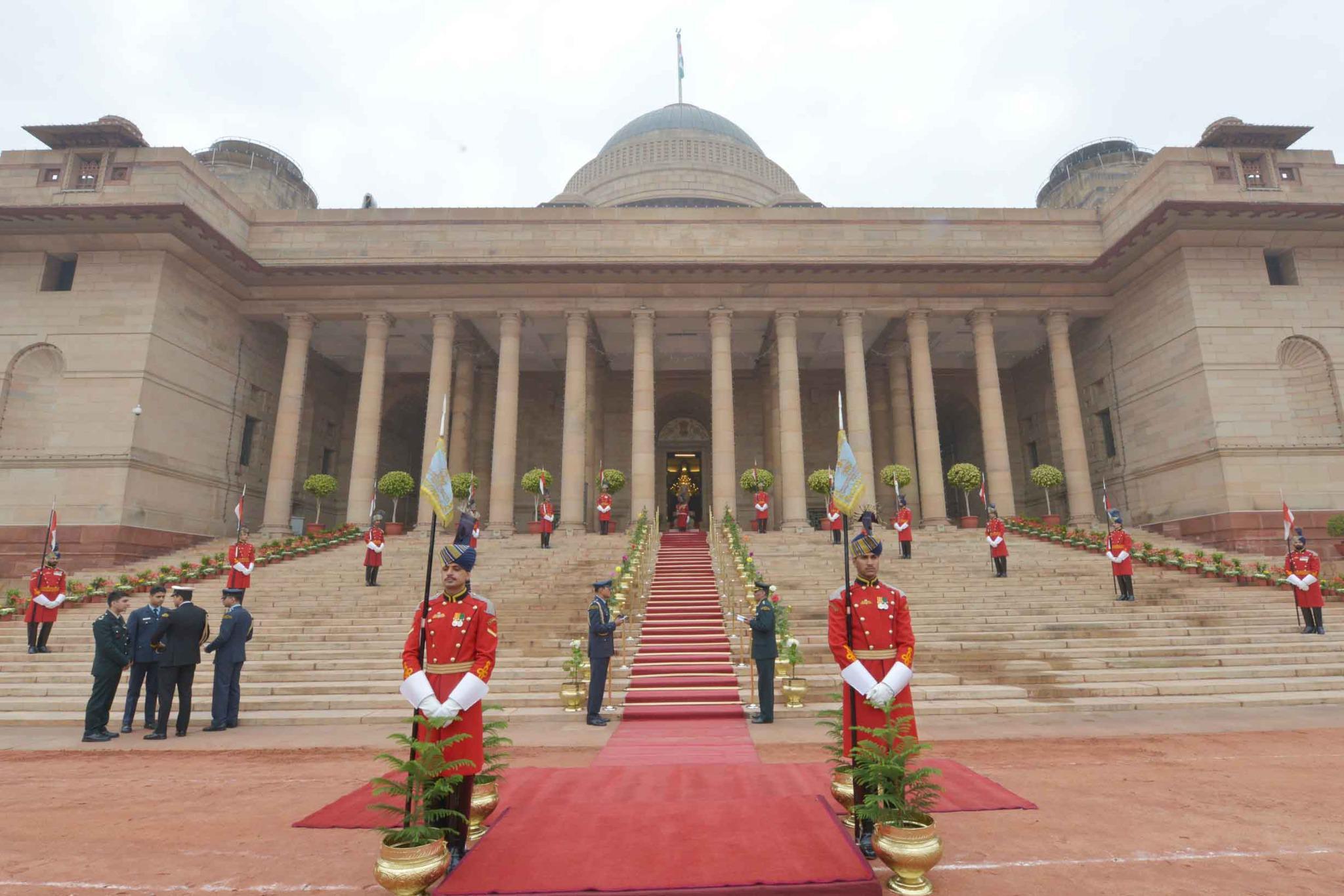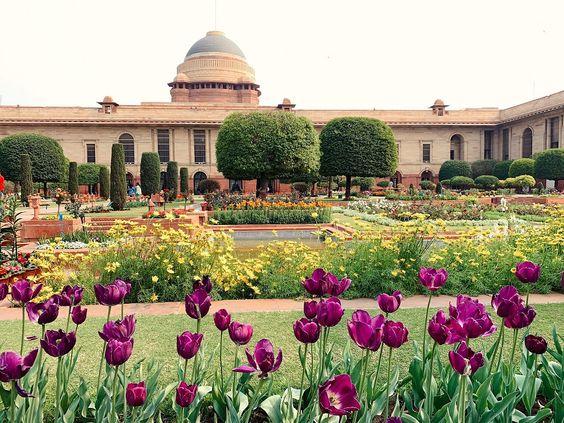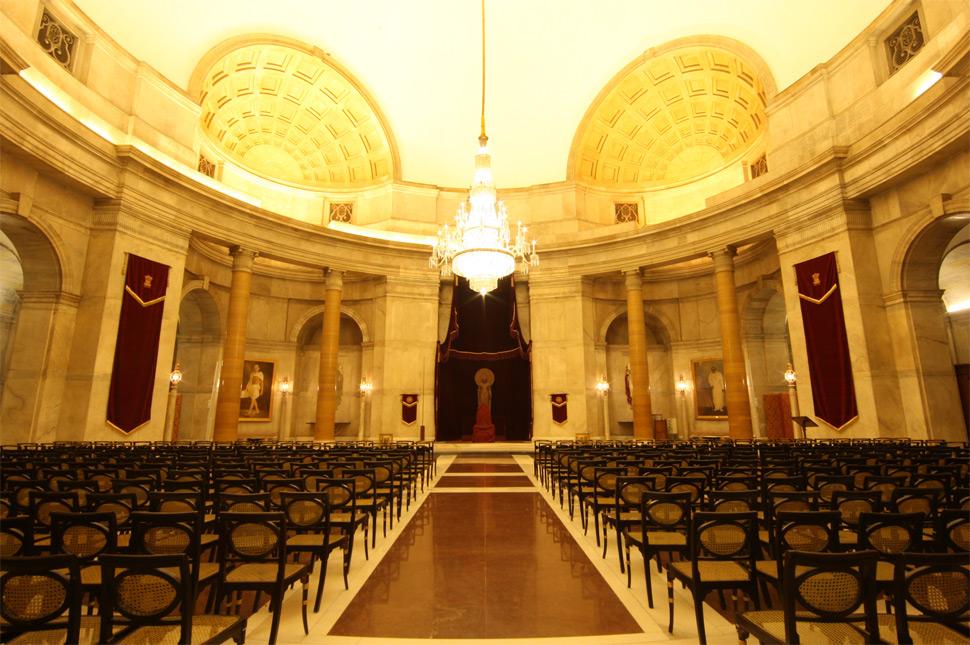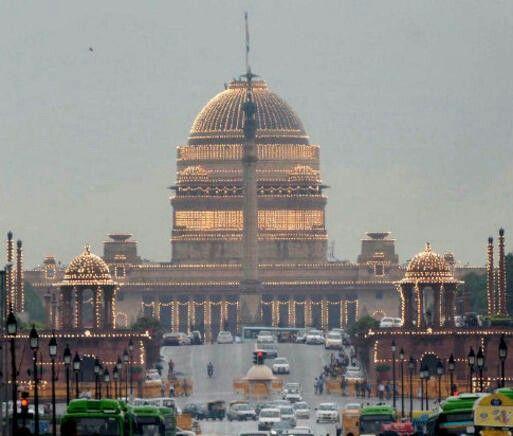



Table of Contents
- Introduction
- Colonial History
- Construction
- Post-Independence Transformation
- Design and Style
- Key Architectural Features
- Key Highlights of Rashtrapati Bhavan
- The Gardens of Rashtrapati Bhavan
- The Rashtrapati Bhavan Museum Complex
- Educational Initiatives
- Role in National Events and Ceremonies
- Diplomatic Engagements
- Green Initiatives
- Educational Programs
- Visiting Rashtrapati Bhavan
- Conclusion
- Faq's
Introduction
Rashtrapati Bhavan, located at the western end of Rajpath in New Delhi, is not merely the official residence of the President of India; it is a monumental symbol of India's democratic values and architectural heritage. As one of the largest residences of a head of state globally, Rashtrapati Bhavan embodies the grandeur of India's rich history, diverse culture, and significant political legacy.
This iconic structure, originally built as the Viceroy's House during British colonial rule, showcases an exquisite blend of Indo-Saracenic and Western architectural styles, designed by the renowned architect Sir Edwin Lutyens.
With its sprawling 330-acre estate, including the beautifully landscaped Mughal Gardens, Rashtrapati Bhavan serves multiple roles like hosting state functions, diplomatic meetings, and national celebrations. The building's historical significance and architectural brilliance make it a must-visit destination for tourists and history enthusiasts alike. This article will delve into the rich history, architectural features, key highlights, and the multifaceted roles that Rashtrapati Bhavan plays.
Colonial History
Rashtrapati Bhavan was originally constructed as the Viceroy's House during British colonial rule. The decision to build a new residence for the Viceroy was made in 1911 when King George V announced the transfer of the capital from Calcutta to New Delhi. The site was chosen for its strategic location, providing a panoramic view of the city and the surrounding landscape
Construction
The construction of Rashtrapati Bhavan began in 1912 and was completed in 1929. The project was led by British architect Sir Edwin Lutyens, who is credited with designing much of New Delhi. Lutyens envisioned a grand structure that would reflect the power and authority of the British Empire while incorporating Indian architectural elements. The construction involved the use of 700 million bricks and 3 million cubic feet of stone, showcasing the immense scale of the project.
Post-Independence Transformation
After India gained independence in 1947, the Viceroy's House was renamed Rashtrapati Bhavan, signifying its new role as the official residence of the President of India. The first President to reside in the building was Dr. Rajendra Prasad. Since then, Rashtrapati Bhavan has witnessed significant political events and ceremonies, becoming a vital part of India's democratic framework.
Design and Style
Rashtrapati Bhavan is a stunning example of Indo-Saracenic architecture, which combines elements of Indian, Mughal, and Western architectural styles. The building's design features a prominent dome, which is a hallmark of Mughal architecture, and is flanked by four corner towers. The central dome, rising to a height of 30.5 meters, is inspired by the Great Stupa at Sanchi.
The façade of Rashtrapati Bhavan is adorned with intricate carvings and jali work, showcasing the craftsmanship of Indian artisans. The use of sandstone and marble adds to the building's grandeur, while the expansive lawns and gardens surrounding the structure enhance its aesthetic appeal.

Key Architectural Features
The Central Dome: The most striking feature of Rashtrapati Bhavan is its central dome, which is inspired by the Pantheon in Rome. The dome is surrounded by a circular colonnade, adding to the building's grandeur.
The Mughal Gardens: The gardens, designed in the Mughal style, are a significant part of Rashtrapati Bhavan. They feature terraced lawns, fountains, and a variety of flowers, making them a picturesque setting.
 Mughal Gardens of Rashtrapati Bhavan
Mughal Gardens of Rashtrapati Bhavan
The Durbar Hall: This grand hall is used for ceremonial functions and is adorned with beautiful chandeliers and intricate woodwork. It serves as a venue for important state functions, including the swearing-in of the President.

The Ashoka Hall: This hall is used for official receptions and is decorated with portraits of past Presidents and other significant figures in Indian history.
The President's Study: This room is where the President conducts official meetings and discussions. It is furnished with elegant furniture and showcases India's cultural heritage through various artworks.
Key Highlights of Rashtrapati Bhavan
Rashtrapati Bhavan is not just an architectural marvel; it is also a repository of India's rich history and culture. Here are some key highlights that make it a significant landmark:
Size and Scale: Rashtrapati Bhavan is one of the largest residences of a head of state in the world, covering an area of 330 acres, including gardens and outbuildings.
Mughal Gardens: The Mughal Gardens, designed in the traditional Mughal style, are open to the public during the Udyanotsav, held every year in February and March. The gardens feature a variety of flowers, including tulips, roses, and marigolds.
Museum Complex: The Rashtrapati Bhavan Museum Complex, inaugurated in 2016, showcases the history of the building, the lives of past Presidents, and the rich cultural heritage of India. It includes exhibitions on art, architecture, and the ceremonial aspects of the presidency.
Ceremonial Functions: Rashtrapati Bhavan serves as the venue for significant national events, including the swearing-in ceremonies of the Prime Minister and other ministers, defense investiture ceremonies, and celebrations of Independence Day and Republic Day.
Diplomatic Engagements: The building plays a crucial role in international diplomacy, hosting foreign dignitaries and heads of state. It serves as a venue for signing treaties and agreements, reinforcing India's position on the global stage.
Sustainable Practices: In recent years, Rashtrapati Bhavan has taken significant steps towards sustainability, including the installation of solar panels, rainwater harvesting systems, and organic farming in the gardens.
Also Read: Natraj Market, Malad: A Shopper's Paradise in Mumbai
The Gardens of Rashtrapati Bhavan
Rashtrapati Bhavan is not only renowned for its architectural grandeur but also for its beautifully landscaped gardens, which are a significant part of its charm and appeal. The Mughal Gardens, designed in the traditional Mughal style, are one of the most beautiful aspects of Rashtrapati Bhavan. Spanning over 13 acres, these gardens are divided into three distinct sections: the Rectangular Garden, the Long Garden, and the Circular Garden, each offering a unique experience for visitors.
Mughal Gardens
The Mughal Gardens are a stunning representation of the rich heritage of Mughal architecture and landscaping. Designed to evoke the essence of the gardens from the Mughal era, these gardens are characterised by their geometric patterns, symmetrical designs, and vibrant floral displays. The gardens are meticulously maintained, showcasing a variety of seasonal flowers, shrubs, and trees that bloom throughout the year, creating a picturesque setting that attracts both locals and tourists.
Rectangular Garden
The Rectangular Garden is the first section visitors encounter and features terraced lawns adorned with vibrant flower beds and a variety of fountains. The layout is reminiscent of the gardens of the Mughal era, with geometric patterns and symmetrical designs that reflect the aesthetic principles of Mughal landscaping. This section is particularly popular for its stunning floral displays, which change with the seasons, offering a colorful spectacle throughout the year. Visitors can enjoy leisurely strolls along the pathways, taking in the beauty of the carefully curated flora and the soothing sounds of flowing water from the fountains.
Long Garden
The Long Garden is characterized by its expansive pathways lined with flowering plants and trees, providing a serene environment for visitors to relax and enjoy the beauty of nature. This section is designed for tranquility, with shaded areas that invite visitors to sit and reflect amidst the lush greenery. The Long Garden's design encourages leisurely walks, making it an ideal spot for families, couples, and nature enthusiasts looking to escape the hustle and bustle of city life. The harmonious blend of colors from the flowers and the rustling leaves creates a peaceful atmosphere that enhances the overall experience of the gardens.
Circular Garden
The Circular Garden is a focal point of the Mughal Gardens, home to a variety of seasonal flowers and plants. Its design aims to create a sense of harmony and tranquility, making it a popular spot for visitors seeking a moment of respite. The circular layout symbolizes unity and completeness, inviting visitors to enjoy the beauty of nature from all angles. This garden is particularly enchanting during the blooming seasons, as the vibrant colors of the flowers create a stunning visual display. The Circular Garden also features seating areas where visitors can relax and immerse themselves in the natural beauty surrounding them.
Biodiversity and Conservation
The gardens of Rashtrapati Bhavan are not only aesthetically pleasing but also serve as a vital habitat for various species of birds and butterflies. The estate is home to over 100 species of birds, making it a haven for birdwatchers and nature enthusiasts. The gardens are maintained with a focus on biodiversity and conservation, promoting sustainable practices and organic gardening techniques.
Efforts to preserve the natural ecosystem within the gardens include planting native species that attract local wildlife and using organic methods to maintain the health of the soil and plants. This commitment to biodiversity ensures that the gardens remain a vibrant and thriving environment, contributing to the overall ecological health of the area.
Educational Initiatives
Rashtrapati Bhavan's gardens also play a role in educational initiatives aimed at raising awareness about environmental conservation and biodiversity. Guided tours often include information about the various plant species, their ecological significance, and the importance of preserving natural habitats. These educational programs are designed to engage visitors, especially students, in understanding the value of nature and the need for sustainable practices.
Also Read: Golconda Fort Hyderabad: A Stronghold of Diamonds, Dynasties, and Design
The Rashtrapati Bhavan Museum Complex
The Rashtrapati Bhavan Museum Complex was inaugurated in 2016 to showcase the rich history and cultural heritage of Rashtrapati Bhavan and the Indian presidency. The museum is housed in the erstwhile stables of the Viceroy's House and features a range of exhibitions that highlight the architectural, historical, and ceremonial significance of the building.
Exhibitions
Presidential History: This exhibition showcases the lives and contributions of past Presidents of India, highlighting their roles in shaping the nation.
Ceremonial Life: Visitors can explore the ceremonial aspects of the presidency, including the rituals and traditions associated with state functions and events.
Art and Architecture: This section focuses on the architectural brilliance of Rashtrapati Bhavan, featuring models, photographs, and artifacts that illustrate its design and construction.
Cultural Heritage: The museum also highlights India's rich cultural heritage through various artworks, textiles, and artifacts that reflect the country's diverse traditions.
Educational Initiatives
The museum complex also offers educational programs and workshops for students and visitors, promoting awareness of India's history, culture, and democratic values. These initiatives aim to engage the public and foster a deeper understanding of the significance of Rashtrapati Bhavan in the Indian Republic.
Role in National Events and Ceremonies

Swearing-In Ceremonies
Rashtrapati Bhavan serves as the venue for the swearing-in ceremonies of the President, Prime Minister, and other ministers. These ceremonies are attended by dignitaries, politicians, and members of the public, symbolizing the democratic process in India. The grandeur of the Durbar Hall, adorned with chandeliers and intricate woodwork, adds to the significance of these events.
Republic Day Celebrations
Every year on January 26, Rashtrapati Bhavan plays a central role in the Republic Day celebrations. The President of India hoists the national flag and takes the salute at the Republic Day parade, which showcases India's military might and cultural diversity. The event is broadcasted nationwide, reinforcing the spirit of patriotism among citizens.
Independence Day Celebrations
On August 15, Rashtrapati Bhavan is the focal point of Independence Day celebrations. The President addresses the nation from the ramparts of the Red Fort, and the building is adorned with lights and decorations, creating a festive atmosphere.
Defense Investiture Ceremonies
Rashtrapati Bhavan also hosts defense investiture ceremonies, where gallantry awards and honors are conferred upon armed forces personnel. These ceremonies are a testament to the bravery and dedication of India's armed forces and are attended by senior military officials and dignitaries.
Diplomatic Engagements
Hosting Foreign Dignitaries
Rashtrapati Bhavan plays a crucial role in India's diplomatic engagements. The President hosts foreign dignitaries, heads of state, and ambassadors, fostering international relations and cooperation. The grandeur of the building serves as a backdrop for important discussions and negotiations.
Signing Treaties and Agreements
The building is also a venue for signing treaties and agreements between India and other nations. These events are significant in strengthening bilateral relations and promoting peace and cooperation on the global stage.
Cultural Diplomacy
Rashtrapati Bhavan serves as a platform for cultural diplomacy, showcasing India's rich heritage to foreign dignitaries. Cultural events, exhibitions, and performances are organised to promote India's art, music, and traditions, fostering mutual understanding and respect among nations.
Green Initiatives
In recent years, Rashtrapati Bhavan has taken significant steps towards sustainability and environmental conservation. The estate has implemented various green initiatives, including:
Solar Energy: The installation of solar panels on the roof of Rashtrapati Bhavan has significantly reduced its carbon footprint, contributing to India's commitment to renewable energy.
Rainwater Harvesting: The estate has implemented rainwater harvesting systems to conserve water and promote sustainable water management practices.
Organic Farming: The gardens of Rashtrapati Bhavan are maintained using organic farming practices, promoting biodiversity and reducing the use of chemical fertilizers and pesticides.
Waste Management: The estate has adopted waste management practices, including segregation of waste and composting, to minimize its environmental impact.
Educational Programs
Rashtrapati Bhavan also conducts educational programs and workshops focused on sustainability and environmental awareness. These initiatives aim to engage the public and promote a culture of conservation and responsible resource management
Visiting Rashtrapati Bhavan
Rashtrapati Bhavan, the official residence of the President of India, is not only a significant architectural landmark but also a treasure trove of history and culture. Open to the public for guided tours, it offers visitors a unique opportunity to explore its rich heritage, stunning gardens, and ceremonial halls. Here's everything you need to know about visiting this iconic site.
Visitor Information
Rashtrapati Bhavan welcomes visitors for guided tours that delve into its historical significance and architectural beauty. The tours cover various sections of the building, including:
The Mughal Gardens: A beautifully landscaped area featuring terraced lawns, vibrant flower beds, and intricate fountains.
The Museum Complex: Showcasing the history of the presidency and the lives of past Presidents through various exhibitions and artifacts.
Ceremonial Halls: Including the grand Durbar Hall and the Ashoka Hall, where significant state functions and ceremonies take place.
Timing and Entry
Timings
Rashtrapati Bhavan is open to visitors from Wednesday to Sunday, with guided tours available in both the morning and afternoon sessions. The specific timings for the tours may vary, so it is advisable to check the official website or contact the visitor center for the most current schedule.
Entry Fee
There is a nominal entry fee for visitors, which helps maintain the gardens and the building. It is highly recommended to book your tickets in advance to secure a spot on the guided tours, especially during peak tourist seasons. Online booking options are available, making it convenient for visitors to plan their trip.
Dress Code
Visitors are required to adhere to a formal dress code while visiting Rashtrapati Bhavan. Appropriate attire includes:
Men: Collared shirts, trousers, and closed-toe shoes. Avoid casual clothing such as shorts, flip-flops, or t-shirts.
Women: Modest dresses, skirts, or trousers paired with a blouse. It is advisable to avoid revealing or overly casual attire.
This dress code not only maintains the dignity of the residence but also reflects the respect associated with visiting a national monument.
Accessibility
Rashtrapati Bhavan is committed to ensuring accessibility for all visitors. Facilities for differently-abled individuals are available, including ramps and designated seating areas during tours. It is advisable to inform the visitor center in advance if any special assistance is required.
Guided Tours
The guided tours of Rashtrapati Bhavan are led by knowledgeable guides who provide insights into the history, architecture, and significance of the various sections of the building. The tours typically last around 1.5 to 2 hours, allowing visitors to immerse themselves in the grandeur of the residence.
Photography
Photography is allowed in certain areas of Rashtrapati Bhavan, particularly in the gardens and some public spaces. However, visitors are advised to respect the guidelines provided by the tour guides regarding photography in restricted areas, such as ceremonial halls.
Visiting Rashtrapati Bhavan offers a unique glimpse into India's rich history and cultural heritage. With its stunning architecture, lush gardens, and significance as the official residence of the President, it is a must-visit destination for anyone interested in exploring the heart of India's political landscape. Ensure you plan your visit ahead of time, adhere to the dress code, and take advantage of the guided tours to fully appreciate the beauty and history of this iconic monument.
Conclusion
Rashtrapati Bhavan stands as a testament to India's rich history, architectural brilliance, and democratic values. As the official residence of the President of India, it embodies the spirit of the nation and serves as a symbol of unity, diversity, and strength. With its stunning architecture, lush gardens, and significant role in national events, Rashtrapati Bhavan continues to captivate the hearts of visitors and citizens alike.
As India progresses into the future, Rashtrapati Bhavan remains a vital part of its identity,
reflecting the country's commitment to democracy, cultural heritage, and sustainable practices. Whether you are a history enthusiast, an architecture lover, or simply curious about India's political landscape, a visit to Rashtrapati Bhavan is an enriching experience that offers a glimpse into the soul of the nation.
explore further
Latest from Editorials
More from Publications
Resources
Dwello, for every home buyer, is a way to go from 'I feel' to 'I know', at no extra cost.




